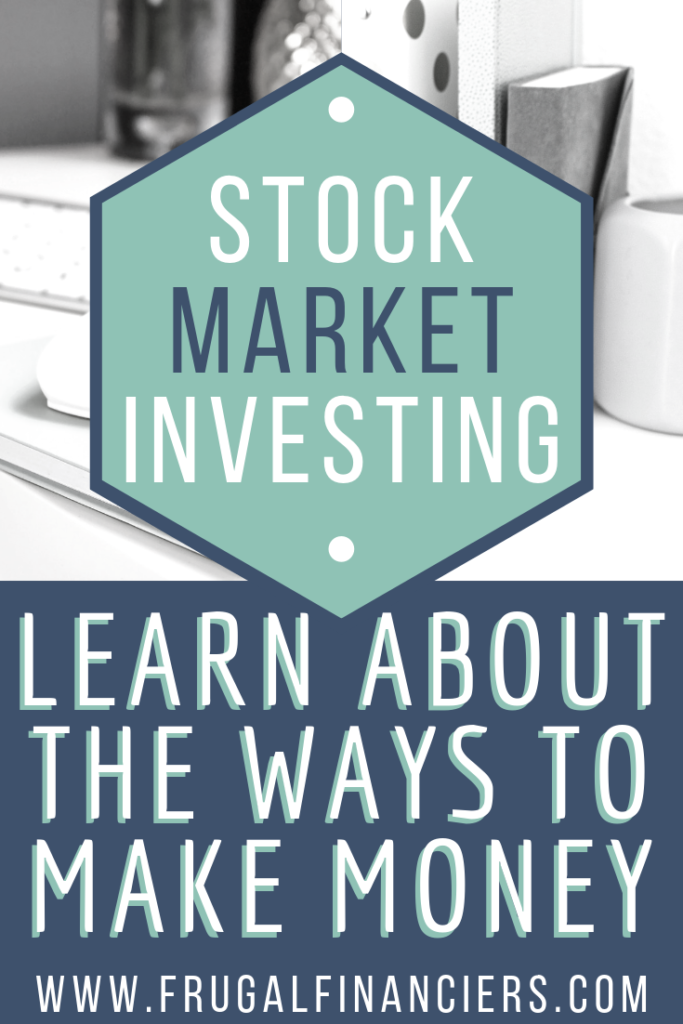Do you want to make money investing in stocks but you don’t really know how the stock market works or the process of investing?
Investing in stocks has been one of the common ways families have built and retained wealth.
But, what about the basics of stock market investing?
Where do you start when you want to make money in stocks?
Here’s what we’ll cover:
- What is a stock?
- What are ETFs and Mutual Funds?
- The process of buying stock
- How do you make money investing in stocks?
What is a Stock?
A stock represents ownership in a company.
It is also referred to as a share or equity.
When you own a stock, in essence, you own a piece of the company it represents.
How much company do you own?
If a company has issued 100 stocks or shares and you own 5 of those shares, you own 5% of the company.
Your ownership of the company is determined by the
Each company has a different amount of shares outstanding so one stock may represent more or less ownership in one company compared to the next.
Generally, one stock or share of a company represents a very small amount of the company.
Like less than 0.01% small.
When you own a stock, generally you have voting rights on matters put forth.
In theory, you own a percentage of future cash flows.
These cash flows are what makes the company valuable.
What are ETFs and Mutual Funds?
If you’ve heard of stocks, you may have also heard of exchange-traded funds (ETFs) and mutual funds.
When you purchase the stock of the company, you are buying ownership of that company and all of the companies it owns.
When you buy an ETF or mutual fund that makes equity investments, you are buying ownership of a group of companies.
While there are differences between mutual funds and ETFs, they are similar in that each fund holds assets like stocks, bonds, or even commodities.
It’s kind of like a middle-man for buying a group of stocks.
You want to buy a group of stocks but you don’t want to go out and buy each company’s shares individually.
So, you buy an ETF or mutual fund which buys each company’s shares individually.
What is the Process of Buying Stock?
If you want to buy stock, or even an ETF, you need access to sellers.
Exchanges were established and bring together buyers and sellers of all types of assets.
But, you cannot simply walk into an exchange and start trading stocks.
You have to open an account through a brokerage firm, which helps match the buyers and sellers of the assets.
As technology has progressed, we have become able to put in orders to buy or sell stocks at our brokerage firm through our computers and phones.
So, here are the steps:
- Open an account at a brokerage firm
- Find the stock, ETF, or mutual fund you want to buy
- Put in an order for how much you want to buy
There are a lot of complex things that go into the final step.
You can choose how much you’re willing to pay for a stock or you can simply pay the current market rate.
It is up to you.
How Do You Make Money Investing in Stocks?
You now know what a stock represents and how to buy it.
But, how do you make money off your shares in a company?
There two main ways that you make money in stocks:
- Asset Appreciation
- Dividends
Both of these ways of making money are different and neither are guaranteed when you purchase stock in a company.
Asset Appreciation
Asset appreciation is when you purchase an asset at one price and it increases in value to another price.
You bought a stock at $25 and now the current market rate is $35.
If you found a buyer willing to pay $35, you could sell your stock, making $10 for each share of equity sold.
There are all kinds of reasons why a stock might increase in value but at the foundation is that people are willing to pay more for the stock.
Maybe the company is generating more cash flows.
Or, there are less shares outstanding so a stock represents greater ownership.
Maybe the company is growing faster.
Hell, there could be some random news story that cause people to pay more to buy the stock.
Dividends
Dividends are cash distributions that the company sends to its shareholders.
Some stocks have dividends and some stocks do not have dividends.
It usually has to do with the cash flows the company is generating.
Generally, more mature companies with steady cash flows will distribute cash out to
You make money when you buy a stock or group of stocks that pay out the dividend.
The cash is put into your account at the brokerage firm.
There are also risks associated with dividends.
A dividend is not guaranteed and there are plenty of companies that stopped paying or reduced their dividends when business slowed.
The dividend yield is the amount paid out annually compared to the price of an individual share.
So, you receive $2.50 in dividends over the year for each share and the price of the stock is $100.
That means that dividend yield is 2.5% = $2.50/$100.
Sometimes, a high-dividend yield can indicate that a company has additional risk.
It’s important to be careful if you are choosing stocks in-part based on the dividend yield of the company.
You could end up purchasing shares of a very risky company.
There’s Also Asset Depreciation
You’re probably just here to learn how you can make money in stocks.
Unfortunately, you can lose money too.
For all of the reasons someone might want to buy a stock, there are opposite reasons why someone would want to sell the share of a company.
Risks are involved in investing and you need to be aware of it.
What could be you just wanting to make some extra money investing in stocks could turn into you losing money, investing in stocks.
Total Return
You should think about asset value and dividends in combination when considering how much money you’re making from investing.
If you’re only focused on one, you may be improperly choosing assets.
If you buy a stock at $100 and get paid a $5 dividend, you made a 5% return.
But, if the stock price is now $90, you’ve actually lost 5%.
If you were just considering the dividend, everything looks good.
When you look at the whole picture, it may different.
There are also plenty of companies that don’t pay a dividend but are growing so strong that the value of the company also grows strong.
You should also consider the fees associated with investing.
Most brokerages charge a trading commission and ETFs and mutual funds also have fees for managing your investments and building the fund.
It is best to have a clear picture of all of gains and revenues as well as all of the costs.
Final Thoughts
Investing in stocks involves risk.
It is also one of the most common methods of building wealth and saving for retirement.
Remember, when you buy a stock, you are buying a piece of the company.
And, when you buy an equity ETF or mutual fund, you are buying pieces of multiple companies.
If you want to make money investing in stocks, the stock either has to appreciate in value or you receive dividends.
But, you should look at these two together.
You might be earning a dividend but the price of the shares of a company has depreciated.
If you are looking for news about the stock market, check out our post:






Leave a Reply
Your email is safe with us.
You must be logged in to post a comment.